
A glove is a garment covering the hand, with separate sheaths or openings for each finger including the thumb. Gloves protect and comfort hands against cold or heat, damage by friction, abrasion or chemicals, and disease; or in turn to provide a guard for what a bare hand should not touch.

An automaton is a relatively self-operating machine, or control mechanism designed to automatically follow a sequence of operations, or respond to predetermined instructions. Some automata, such as bellstrikers in mechanical clocks, are designed to give the illusion to the casual observer that they are operating under their own power or will, like a mechanical robot. The term has long been commonly associated with automated puppets that resemble moving humans or animals, built to impress and/or to entertain people.

Scissors are hand-operated shearing tools. A pair of scissors consists of a pair of blades pivoted so that the sharpened edges slide against each other when the handles (bows) opposite to the pivot are closed. Scissors are used for cutting various thin materials, such as paper, cardboard, metal foil, cloth, rope, and wire. A large variety of scissors and shears all exist for specialized purposes. Hair-cutting shears and kitchen shears are functionally equivalent to scissors, but the larger implements tend to be called shears. Hair-cutting shears have specific blade angles ideal for cutting hair. Using the incorrect type of scissors to cut hair will result in increased damage or split ends, or both, by breaking the hair. Kitchen shears, also known as kitchen scissors, are intended for cutting and trimming foods such as meats.
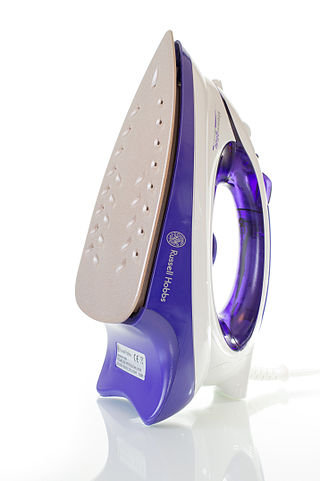
A clothes iron is a small appliance that, when heated, is used to press clothes to remove wrinkles and unwanted creases. Domestic irons generally range in operating temperature from between 121 °C (250 °F) to 182 °C (360 °F). It is named for the metal (iron) of which the device was historically made, and the use of it is generally called ironing, the final step in the process of laundering clothes.

A thimble is a small pitted cup worn on the finger that protects it from being pricked or poked by a needle while sewing. The Old English word þȳmel, the ancestor of thimble, is derived from Old English þūma, the ancestor of the English word thumb.

The Virginian Railway was a Class I railroad located in Virginia and West Virginia in the United States. The VGN was created to transport high quality "smokeless" bituminous coal from southern West Virginia to port at Hampton Roads.

Shell cordovan,cordovan, or cordwain is a type of tanned fibrous connective tissue commonly used in high-end shoemaking. Cordovan is an equine material made from the fibrous flat connective tissue beneath the hide on the rump of the horse. The material derives its name from the city of Cordoba, Spain, where it was first produced by the Visigoths in the seventh century, and later also by the Moors. It is a difficult and expensive material to make, and in the late 19th and early 20th century was mostly used for razor strops to hone razors in barber shops. More recently it has been increasingly used for shoes, wallets, and watch straps due to its aesthetic qualities and exceptional durability. It is also used in archery to protect the fingers. It is smooth and durable, ideal for a finger tab. Shell cordovan has a unique non-creasing characteristic. Because it is made of connective tissue, it is smooth and lacks the pebbled effect of leather derived from animal skin.

Cock and ball torture (CBT) is a sexual activity involving the application of pain or constriction to the male genitals. This may involve directly painful activities, such as genital piercing, wax play, genital spanking, squeezing, ball-busting, genital flogging, urethral play, tickle torture, erotic electrostimulation, kneeing, or kicking. The recipient of such activities may receive direct physical pleasure via masochism, emotional pleasure through erotic humiliation, or knowledge that the play is pleasing to a sadistic dominant. Many of these practices carry significant health risks.

William Nelson Page was an American civil engineer and industrialist. He was active in the Virginias following the U.S. Civil War. Page was widely known as a metallurgical expert by other industry leaders and investors as well as state and federal authorities.

A gauntlet is a type of glove that protects the hand and wrist of a combatant. Gauntlets were used particularly in Europe between the early fourteenth century and the early modern period and were often constructed of hardened leather or metal plates.
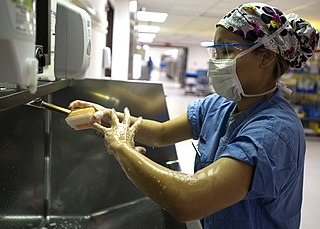
Asepsis is the state of being free from disease-causing micro-organisms. There are two categories of asepsis: medical and surgical. The modern day notion of asepsis is derived from the older antiseptic techniques, a shift initiated by different individuals in the 19th century who introduced practices such as the sterilizing of surgical tools and the wearing of surgical gloves during operations. The goal of asepsis is to eliminate infection, not to achieve sterility. Ideally, a surgical field is sterile, meaning it is free of all biological contaminants, not just those that can cause disease, putrefaction, or fermentation. Even in an aseptic state, a condition of sterile inflammation may develop. The term often refers to those practices used to promote or induce asepsis in an operative field of surgery or medicine to prevent infection.
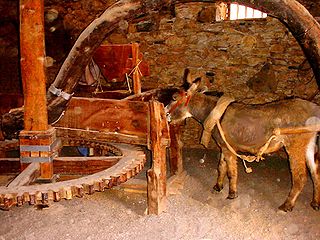
A horse mill is a mill, sometimes used in conjunction with a watermill or windmill, that uses a horse engine as the power source. Any milling process can be powered in this way, but the most frequent use of animal power in horse mills was for grinding grain and pumping water. Other animal engines for powering mills are powered by dogs, donkeys, oxen or camels. Treadwheels are engines powered by humans.
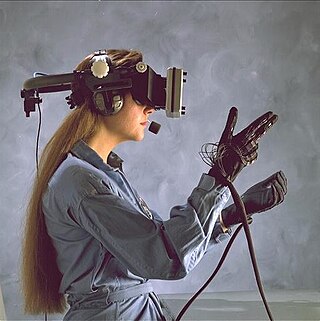
A wired glove is an input device for human–computer interaction worn like a glove.
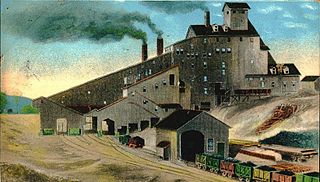
A coal breaker is a coal processing plant which breaks coal into various useful sizes. Coal breakers also remove impurities from the coal and deposit them into a culm dump. The coal breaker is a forerunner of the modern coal preparation plant.

Sawahlunto is a city in West Sumatra, Indonesia. It lies 90 kilometres from Padang, the provincial capital. Sawahlunto is known as the site for the oldest coal mining site in Southeast Asia. Sawahlunto is geographically located in a narrow valley along the Bukit Barisan mountains and surrounded by several hills, namely Bukit Polan, Bukit Pari, and Bukit Mato. The town has a land area of 273.45 sq. km, and had a population of 56,866 at the 2010 Census, 60,136 at the 2015 Census, and 65,138 at the 2020 Census; the official estimate as at mid-2023 was 67,760 - comprising 34,090 males and 33,670 females.

Ancient Greek boxing dates back to at least the 8th century BC, and was practiced in a variety of social contexts in different Greek city-states. Most extant sources about ancient Greek boxing are fragmentary or legendary, making it difficult to reconstruct the rules, customs and history surrounding this activity in great detail. Still, it is clear that gloved boxing bouts were a significant part of ancient Greek athletic culture throughout the early classical period.

Fashion in the period 1900–1909 in the Western world continued the severe, long and elegant lines of the late 1890s. Tall, stiff collars characterize the period, as do women's broad hats and full "Gibson Girl" hairstyles. A new, columnar silhouette introduced by the couturiers of Paris late in the decade signaled the approaching abandonment of the corset as an indispensable garment.

Bersham is a village in Wrexham County Borough, Wales, that lies next to the River Clywedog, and is in the community of Esclusham. Bersham was historically a major industrial centre of the area, but despite this the village still retains a rural feeling.

A toilet service is a set of objects for use at the dressing table. The term is usually reserved for large luxury sets from the 17th to 19th centuries, with toilet set or vanity set used for later or simpler sets. Historically, services were made in metal, ceramics, and other materials, for both men and women, though male versions were generally much smaller. The rich had services in gold, silver, or silver-gilt. The contents vary, but typically include a mirror, one or more small ewers and basins, two candlesticks, and an assortment of bowls, boxes, caskets, and other containers. One or more brushes and a pin-cushion, often as a top to a box, are often included. The sets usually came with a custom-made travelling case, and some services were especially designed for travelling.



















